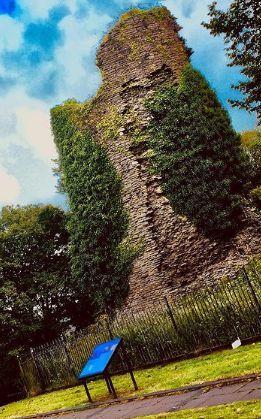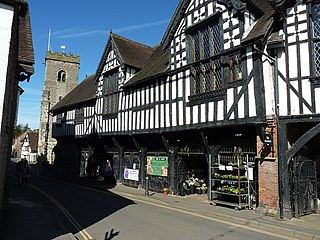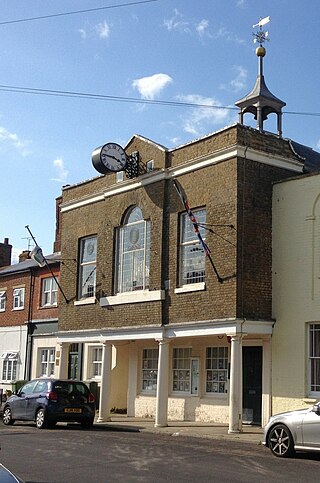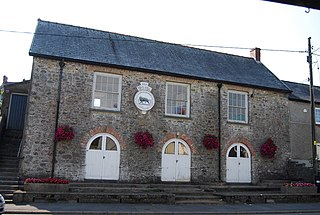
Llantrisant is a town in the county borough of Rhondda Cynon Taf, within the historic county boundaries of Glamorgan, Wales, lying on the River Ely and the Afon Clun. The three saints of the town's name are SS. Illtyd, Gwynno, and Dyfodwg. Llantrisant is a hilltop settlement, at an altitude of 174 m (571 ft) above sea level. The town is home to the Royal Mint.

The Much Wenlock Guildhall is a guildhall located on Wilmore Street in Much Wenlock, Shropshire. It is a Grade II* listed building.

Cowbridge Town Hall is a public building in the High Street of Cowbridge in South Wales. The town hall, which is the meeting place for Cowbridge with Llanblethian Town Council, and also houses the town clerk's office, the committee rooms and the Cowbridge Museum, is a Grade II* listed building.

Llanelli Town Hall is a municipal building in Church Street, Llanelli, Carmarthenshire, South Wales. The town hall, which was the headquarters of Llanelli Borough Council, is a Grade II listed building.

Tavistock Town Hall is a municipal building in Bedford Square, Tavistock, Devon, England. The structure, which remains the main venue for civic events in the town, is a Grade II listed building.

Conwy Guildhall is a municipal structure in Rose Hill Street, Conwy, Wales. The guildhall, which is the meeting place of Conwy Town Council, is a Grade II listed building.

Queenborough Guildhall is a former municipal building in the High Street in Queenborough, Kent, England. The structure, which is currently used as a museum, is a Grade II listed building.

The Guildhall is a municipal building in Fore Street in Plympton, Devon, England. The structure, which is used as a community events venue, is a Grade II* listed building.

Garstang Town Hall is a municipal building in the High Street in Garstang, Lancashire, England. The structure, which currently accommodates two shops and a Royal British Legion Club, is a Grade II listed building.

Laugharne Town Hall is a municipal building in Market Street in Laugharne, Carmarthenshire, Wales. The structure, which is the meeting place of Laugharne Corporation, is a Grade II* listed building.

Tenby Town Hall is a municipal building in the High Street, Tenby, Pembrokeshire, Wales. The structure, which is used as an events venue, is a Grade II listed building.

Crickhowell Market Hall, formerly Crickhowell Town Hall, is a municipal building in the High Street, Crickhowell, Powys, Wales. The structure, which accommodates market stalls on the ground floor and a café on the first floor, is a Grade II* listed building.

Looe Guildhall is a municipal building in Fore Street in Looe, Cornwall, England. The structure, which is currently used as a community events venue, is a Grade II listed building.

The Old Guildhall is a municipal building in Higher Market Street in Looe, Cornwall, England. The structure, which is currently used as a museum, is a Grade II* listed building.

Bradninch Guildhall is a municipal building in Fore Street, Bradninch, Devon, England. The structure, which is now used as a community events venue, is a Grade II listed building.

Lydd Guildhall, also known as Lydd Town Hall and the Lydd Common House, is a municipal building in the High Street, Lydd, Kent, England. The structure, which accommodates the offices and meeting place of Lydd Town Council, is a Grade II listed building.

Pevensey Court House, formerly known as Pevensey Town Hall, is a municipal building in the High Street, Pevensey, East Sussex, England. The structure, which currently accommodates a local history museum, is a Grade II listed building.

St Clears Town Hall is a municipal building in the High Street, St Clears, Carmarthenshire, Wales. The structure, which is currently disused, is a Grade II listed building.

The Prince of Wales Inn, formerly Kenfig Town Hall, is a public house in Heol Gorllewin, Kenfig, Bridgend County Borough, Wales. The structure, which used to be a municipal building, is a Grade II listed building.

The Old Town Hall is a former municipal building in Castle Street in Loughor, a town in Swansea, Wales. The structure, which used to be the neeting place of the local borough council, is a Grade II listed building.





















